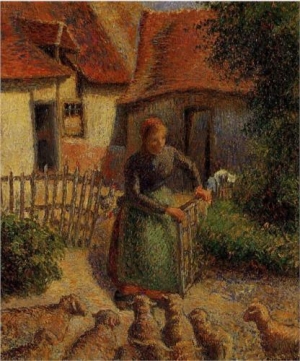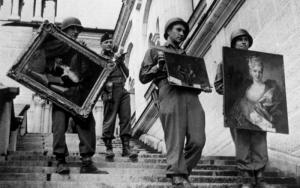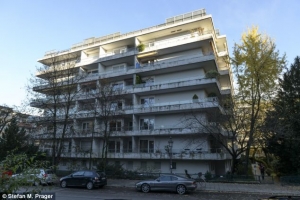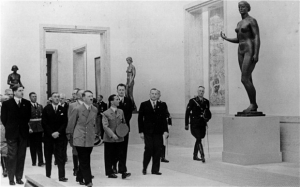|
Displaying items by tag: Nazis
On Tuesday, January 21, France’s Minister of Culture and Communication, Aurélie Filippetti, announced that the country would return three artworks that were looted during World War II to their rightful owners. The works include a 17th century landscape by the Flemish painter Joos de Momper, an 18th century portrait, and an oil on wood Madonna.
The works are among over 2,000 objects that have been held in temporary custody by French museums since the end of World War II. Some critics have spoken out against France, claiming that the country has not been proactive enough in terms of restitution efforts.
Since the end of World War II, France has returned around 80 looted artworks.

Leone Meyer, the daughter of Raoul Meyer, a Jewish businessman who lived in Paris during the Nazi occupation, is suing Oklahoma University and its Fred Jones Jr. Museum of Art over Camille Pissarro’s painting ‘Shepherdess Bringing in Sheep.’ Meyer claims that the work, which resides in the museum’s collection, was stolen from her father by the Nazis.
Before Paris fell under Nazi control, Raoul Meyer assembled a large collection of French Impressionist works that were later seized during the occupation. After World War II ended, Raoul spent years trying to reassemble his comprehensive collection. In 1953, he sued Christoph Bernoulli, a Swiss art dealer and then-owner of the Pissarro painting. The case was dismissed due to a statute of limitations on such cases and ‘Shepherdess Bringing in Sheep’ eventually made its way to an art gallery in New York where it was purchased by the oil magnate, Aaron Weitzenhoffer and his wife, Clara. Following Clara’s death in 2000, the painting was donated to the Fred Jones Jr. Museum of Art. The Weitzenhoffers’ son claims that his parents were unaware of the painting's troubled provenance.
So far, the university has refused to return the work to Meyer, citing the previous court ruling in Switzerland.

London’s Victoria & Albert Museum holds the only known copy of a complete list of “degenerate art” that was confiscated by Nazis from public institutions in Germany. The Entartete Kunst was compiled by Hitler’s Ministry for Public Enlightenment and Propaganda and includes information on the provenance and fate of each work. The list was donated to the museum by the widow of Heinrich Fischer, an Austrian-born art dealer, in 1996. Since its acquisition, the Entartete Kunst has been used by provenance researchers from around the world.
For the first time ever, the Victoria & Albert Museum will make images of the original pages of the Entartete Kunst available online. The 479-page volume lists institutions alphabetically by location and for each museum, the confiscated works are listed and include information on what happened to each piece. For many works, the name of the buyer and a price are given, while others are marked with an “x,” indicating that they were destroyed.
The Nazis deemed any work that was “un-German” or “Jewish Bolshevist“ in nature degenerate art. While virtually all modern art was deemed degenerate, the Nazis promoted paintings and sculptures that were traditional in nature. The Nazis forced avant-garde German artists into exile and their works were either sold at auction or acquired by museums or collectors. In 1942, a large portion of so-called degenerate works by Pablo Picasso, Salvador Dalí, Paul Klee, Fernand Léger and Joan Miró were destroyed in a bonfire.
A PDF of the Entartete Kunst will be made available on the Victoria & Albert museum’s website starting at the end of January.

An art historian is claiming that two artworks residing inside Germany’s parliament were stolen from their rightful owners by Nazis during World War II. The shocking discovery ran in an article in Bild newspaper on Monday, December 30.
The historian’s investigation into the German parliament’s art collection began in 2012 and determined that an oil painting by Georg Waltenberger and a chalk lithograph by Lovis Corinth had been stolen by Nazis. One of the works was acquired by the parliament from Cornelius Gurlitt, a recluse who was recently accused of hoarding hundreds of masterpieces stolen by Nazis. Gurlitt’s father, Hildebrandt, had been put in charge of selling the stolen artworks by Joseph Goebbels, Hitler’s Minister of Propaganda, but secretly hoarded many of them.
The parliament’s art collection is comprised of nearly 4,000 works and according to investigations, 108 of those pieces are of unknown provenance. The Central Council of Jews in Germany has called for a list of the parliament’s artworks to be published.

A long-lost impressionist masterpiece by Camille Pissarro will be sold at Sotheby’s London on February 5, 2014. ‘Boulevard Montmartre, Matinée de Printemps’ (1897) is expected to sell for £7 million to £10 million during the auction house’s Impressionist and Modern Art Evening Sale.
The painting belonged to the wealthy industrialist Max Silberberg, who amassed a considerable collection of 19th and 20th century artwork by masters such as Pierre-Auguste Renoir, Gustave Courbet, Edgar Degas, Edouard Manet, and Vincent Van Gogh. Between 1935 and 1937, Nazis forced Silberberg to sell his entire art collection before deporting him and his wife to Auschwitz, where they both perished. Silberberg’s son, Alfred, and his wife, Gerta, survived the Holocaust and fled to England. Following Alfred’s death in 1984, Gerta worked tirelessly to locate her late father-in-law’s collection. ‘Boulevard Montmartre’ was restituted to her in 2000 after having spent many years in the Israel Museum’s collection in Jerusalem. Gerta later loaned the painting back to the museum where it remained on public view until her death earlier this year.
Profits from the sale of the Pissarro painting will support the charitable causes championed by the late Gerta Silberberg.

German authorities announced that they would return a number of paintings to Cornelius Gurlitt, a recluse accused of hoarding hundreds of masterpieces stolen by the Nazis. Reinhard Nemetz, The chief prosecutor who is handling Gurlitt’s case, acknowledged that several of the works confiscated from Gurlitt's home clearly belonged to him. A task force was appointed to identify such paintings as soon as possible. Authorities stated that out of the 1,406 paintings, sketches and prints found in Gurlitt’s home, about 970 were suspected of being looted from Jewish families or taken from museums during World War II.
Gurlitt is the son of the art dealer Hildebrandt Gurlitt, who reportedly aquired the art trove in the late 1930s and 1940s. Hildebrandt Gurlitt had been put in charge of selling the stolen artworks abroad by Joseph Goebbels, Hitler’s Minister of Propaganda, but secretly hoarded many of them and later claimed that they were destroyed in the bombing of Dresden. Cornelius Gurlitt, who is unemployed, sold a number of the paintings over the years and lived off of the profits.
Determining the provenance of works by such luminaries as Pablo Picasso and Pierre-Auguste Renoir is expected to be a lengthy process, especially since Gurlitt is determined not to give up the artworks without a fight. He told Germany’s Der Spiegel magazine, “I will not give anything back voluntarily.”

Two organizations affiliated with the Secession building in Vienna where Gustav Klimt’s masterpiece, Beethoven Frieze, is housed, have spoken out against the heirs of the work’s former owner. The heirs of Erich Lederer, who fled Vienna when the Nazis annexed Austria in 1938, filed a request with Austria’s Art Restitution Advisory Board under a law that regulates the return of Nazi-looted artwork. The claim was made possible after Austria expanded the law in 2009 to cover instances where previous owners were forced to sell their artworks for unreasonably low values following World War II.
In response to the heirs’ claims, the Association of Visual Artists Vienna Secession and Friends of the Secession filed a statement saying that after studying the historical record and their consciences they had determined that the “claimants are in the wrong” adding that restitution would “trivial real injustice and debase any other genuine claims.”
Lederer’s Klimt painting was seized by the Nazis and later returned following World War II. Austrian officials would only allow Lederer to export other restituted artworks if he sold Beethoven Frieze for $75,000; half of what Christie’s estimated the painting to be worth at the time.
Switzerland paid $1.6 million in legal fees despite winning a U.S. lawsuit over a drawing by Vincent van Gogh, which was donated by a businessman accused of exploiting the work’s former owner. The heir of Margaret Mauthner, a Jewish art collector who sold the drawing to Swiss businessman Oskar Reinhart in 1933 before fleeing Nazi Germany, brought the case against Switzerland in 2009.
The heir claimed that Reinhart, who gave the drawing Street in Saintes-Maries to Switzerland, had taken advantage of her grandmother’s unfortunate circumstance and forced her to sell the work for an unfair price. Switzerland maintained that Reinhart had paid a reasonable price for the drawing and ultimately won the case.
The work, which is valued at several million dollars, is currently on view in the Reinhart collection at the Winterthur Museum in northeastern Switzerland.

The German government has released some details about the astounding art collection found in a dilapidated Munich apartment. Authorities released a written statement saying that about 590 of the 1,400 artworks could have been stolen by Nazis and identified 25 of the pieces on the website www.lostart.de. Among the paintings listed on the site were Otto Dix’s The Woman in the Theater Box, Otto Griebel’s Child at the Table and Max Liebermann’s Rider on the Beach. The trove also includes works by Henri Matisse, Marc Chagall and Pablo Picasso.
The masterpieces were found in the apartment of Cornelius Gurlitt, the son of the art dealer Hildebrandt Gurlitt, who reportedly acquired the works in the late 1930s and 1940s. Gurlitt’s father had been put in charge of selling the stolen artworks abroad by Joseph Goebbels, Hitler’s Minister of Propaganda, but secretly hoarded many of them and later claimed that they were destroyed in the bombing of Dresden. Gurlitt, an unemployed recluse, sold a number of the paintings over the years and lived off of the profits. 200 of the pieces have outstanding return requests from the original owners’ heirs.
The German government has assembled a task force of six experts to research the provenance of each recently discovered artwork. To date, it has been determined that one painting by Matisse was stolen by the Nazis from a French bank in 1942.
German officials will update the Lost Art website regularly as the investigation progresses.

Around 1,500 artworks worth approximately one billion euros ($1.35 billion) were found in a dilapidated apartment in Munich. The shocking discovery was made public on Sunday, November 3 by the German news magazine, Focus. The trove includes works by celebrated impressionist and modern masters such as Henri Matisse, Marc Chagall and Pablo Picasso as well as Old Masters including Albrecht Durer.
The masterpieces, which were allegedly confiscated by Nazis or sold under duress by their Jewish owners, were found in the apartment of Cornelius Gurlitt, the son of the art dealer Hildebrandt Gurlitt, who reportedly acquired the works in the late 1930s and 1940s. Gurlitt’s father had been put in charge of selling the stolen artworks abroad by Joseph Goebbels, Hitler’s Minister of Propaganda, but secretly hoarded many of them and later claimed that they were destroyed in the bombing of Dresden. Gurlitt, an unemployed recluse, sold a number of the paintings over the years and lived off of the profits. 200 of the pieces have outstanding return requests from the original owners’ heirs.
In a shocking twist, it was revealed that officials have known about the looted artworks since 2011, when investigators searched Gurlitt’s apartment after he was caught by customs authorities on a train from Switzerland to Munich with a large amount of cash. Julian Radcliffe, chairman of the Art Loss Register, told AFP, “I think it’s the biggest find of Holocaust pictures that there’s been for years, but it’s still a tiny fraction of the total number of pictures that we’re looking for.” The works are currently being held in a customs warehouse outside of Munich.
|
|
|
|
|